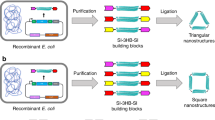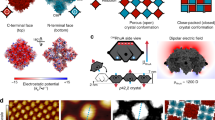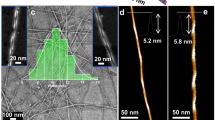Abstract
A promising route to the synthesis of protein-mimetic materials that are capable of complex functions, such as molecular recognition and catalysis, is provided by sequence-defined peptoid polymers1,2—structural relatives of biologically occurring polypeptides. Peptoids, which are relatively non-toxic and resistant to degradation3, can fold into defined structures through a combination of sequence-dependent interactions3,4,5,6,7,8. However, the range of possible structures that are accessible to peptoids and other biological mimetics is unknown, and our ability to design protein-like architectures from these polymer classes is limited9. Here we use molecular-dynamics simulations, together with scattering and microscopy data, to determine the atomic-resolution structure of the recently discovered peptoid nanosheet, an ordered supramolecular assembly that extends macroscopically in only two dimensions. Our simulations show that nanosheets are structurally and dynamically heterogeneous, can be formed only from peptoids of certain lengths, and are potentially porous to water and ions. Moreover, their formation is enabled by the peptoids’ adoption of a secondary structure that is not seen in the natural world. This structure, a zigzag pattern that we call a Σ(‘sigma’)-strand, results from the ability of adjacent backbone monomers to adopt opposed rotational states, thereby allowing the backbone to remain linear and untwisted. Linear backbones tiled in a brick-like way form an extended two-dimensional nanostructure, the Σ-sheet. The binary rotational-state motif of the Σ-strand is not seen in regular protein structures, which are usually built from one type of rotational state. We also show that the concept of building regular structures from multiple rotational states can be generalized beyond the peptoid nanosheet system.
This is a preview of subscription content, access via your institution
Access options
Subscribe to this journal
Receive 51 print issues and online access
$199.00 per year
only $3.90 per issue
Buy this article
- Purchase on Springer Link
- Instant access to full article PDF
Prices may be subject to local taxes which are calculated during checkout





Similar content being viewed by others
References
Knight, A. S., Zhou, E. Y., Francis, M. B. & Zuckermann, R. N. Sequence programmable peptoid polymers for diverse materials applications. Adv. Mater http://dx.doi.org/10.1002/adma.201500275 (2015)
Zuckermann, R. N. & Kodadek, T. Peptoids as potential therapeutics. Curr. Opin. Mol. Ther. 11, 299–307 (2009)
Sun, J. & Zuckermann, R. N. Peptoid polymers: a highly designable bioinspired material. ACS Nano 7, 4715–4732 (2013)
Butterfoss, G. L. et al. De novo structure prediction and experimental characterization of folded peptoid oligomers. Proc. Natl Acad. Sci. USA 109, 14320–14325 (2012)
Yoo, B. & Kirshenbaum, K. Peptoid architectures: elaboration, actuation, and application. Curr. Opin. Chem. Biol. 12, 714–721 (2008)
Laursen, J. S., Engel-Andreasen, J., Fristrup, P., Harris, P. & Olsen, C. A. Cis-trans amide bond rotamers in β-peptoids and peptoids: evaluation of stereoelectronic effects in backbone and side chains. J. Am. Chem. Soc. 135, 2835–2844 (2013)
Butterfoss, G. L., Renfrew, P. D., Kuhlman, B., Kirshenbaum, K. & Bonneau, R. A preliminary survey of the peptoid folding landscape. J. Am. Chem. Soc. 131, 16798–16807 (2009)
Nam, K. T. et al. Free-floating ultrathin two-dimensional crystals from sequence-specific peptoid polymers. Nature Mater. 9, 454–460 (2010)
Drexler, K. E. Peptoids at the 7th Summit: toward macromolecular systems engineering. Biopolymers 96, 537–544 (2011)
Sanii, B. et al. Shaken, not stirred: collapsing a peptoid monolayer to produce free-floating, stable nanosheets. J. Am. Chem. Soc. 133, 20808–20815 (2011)
Kudirka, R. et al. Folding of a single-chain, information-rich polypeptoid sequence into a highly ordered nanosheet. Biopolymers 96, 586–595 (2011)
Sanii, B. et al. Structure-determining step in the hierarchical assembly of peptoid nanosheets. ACS Nano 8, 11674–11684 (2014)
Robertson, E. J. et al. Assembly and molecular order of two-dimensional peptoid nanosheets through the oil-water interface. Proc. Natl Acad. Sci. USA 111, 13284–13289 (2014)
Brooks, B. R. et al. CHARMM: the biomolecular simulation program. J. Comput. Chem. 30, 1545–1614 (2009)
Mirijanian, D. T., Mannige, R. V., Zuckermann, R. N. & Whitelam, S. Development and use of an atomistic CHARMM-based forcefield for peptoid simulation. J. Comput. Chem. 35, 360–370 (2014)
Karplus, M. & McCammon, J. A. The internal dynamics of globular proteins. CRC Crit. Rev. Biochem. 9, 293–349 (1981)
Halle, B. Flexibility and packing in proteins. Proc. Natl Acad. Sci. USA 99, 1274–1279 (2002)
Berg, J. M., Tymoczko, J. L. & Stryer, L. Biochemistry, International Edition 7th edn (WH Freeman & Co., 2010)
Hammer, N. D., Wang, X., McGuffie, B. A. & Chapman, M. R. Amyloids: friend or foe? J. Alzheimers Dis. 13, 407–419 (2008)
Knowles, T. P., Oppenheim, T. W., Buell, A. K., Chirgadze, D. Y. & Welland, M. E. Nanostructured films from hierarchical self-assembly of amyloidogenic proteins. Nature Nanotechnol. 5, 204–207 (2010)
Sun, J., Teran, A. A., Liao, X., Balsara, N. P. & Zuckermann, R. N. Crystallization in sequence-defined peptoid diblock copolymers induced by microphase separation. J. Am. Chem. Soc. 136, 2070–2077 (2014)
Maulucci, N. et al. Synthesis, structures, and properties of nine-, twelve-, and eighteen-membered N-benzyloxyethyl cyclic α-peptoids. Chem. Commun. 33, 3927–3929 (2008)
Zhang, W. et al. PEG-stabilized bilayer nanodisks as carriers for doxorubicin delivery. Mol. Pharm. 11, 3279–3290 (2014)
Rosen, M. J. & Kunjappu, J. T. Surfactants and Interfacial Phenomena (John Wiley & Sons, 2012)
Leopold, P. E., Montal, M. & Onuchic, J. N. Protein folding funnels: a kinetic approach to the sequence-structure relationship. Proc. Natl Acad. Sci. USA 89, 8721–8725 (1992)
Bryngelson, J. D., Onuchic, J. N., Socci, N. D. & Wolynes, P. G. Funnels, pathways, and the energy landscape of protein folding: a synthesis. Proteins 21, 167–195 (1995)
Schug, A. & Onuchic, J. N. From protein folding to protein function and biomolecular binding by energy landscape theory. Curr. Opin. Pharmacol. 10, 709–714 (2010)
Shan, Y. et al. How does a drug molecule find its target binding site? J. Am. Chem. Soc. 133, 9181–9183 (2011)
Hoover, W. G. Canonical dynamics: equilibrium phase-space distributions. Phys. Rev. A 31, 1695–1697 (1985)
Allen, M. P. & Tildesley, D. J. Computer Simulation of Liquids (Oxford Univ. Press, 1989)
Chantler, C. Theoretical form factor, attenuation, and scattering tabulation for Z = 1–92 from E = 1–10 eV to E = 0.4–1.0 MeV. J. Phys. Chem. Ref. Data 24, 71 (1995)
Kabsch, W. & Sander, C. Dictionary of protein secondary structure: pattern recognition of hydrogen-bonded and geometrical features. Biopolymers 22, 2577–2637 (1983)
Lee, C., Yang, W. & Parr, R. G. Development of the Colle-Salvetti correlation-energy formula into a functional of the electron density. Phys. Rev. B 37, 785–789 (1988)
Zhao, Y., Schultz, N. E. & Truhlar, D. G. Exchange-correlation functional with broad accuracy for metallic and nonmetallic compounds, kinetics, and noncovalent interactions. J. Chem. Phys. 123, 161103 (2005)
Frisch, M. J. et al. Gaussian09 Revision D.01 (Gaussian Inc., Wallingford, 2009)
Roothaan, C. C. J. New developments in molecular orbital theory. Rev. Mod. Phys. 23, 69–99 (1951)
Acknowledgements
Portions of this work were done as a User project at the Molecular Foundry at Lawrence Berkeley National Laboratory, supported by the Office of Science, Office of Basic Energy Sciences, of the US Department of Energy under contract no. DE-AC02-05CH11231. R.V.M., T.K.H., C.P., E.J.R., A.B., R.N.Z. and S.W. were supported by the Defense Threat Reduction Agency under contract no. IACRO-B0845281. C.P. was also supported by the Natural Sciences and Engineering Research Council of Canada (NSERC PDF). R.N.Z. and S.W. were also supported by the Office of Science, Office of Basic Energy Sciences, of the US Department of Energy under contract no. DE-AC02-05CH11231. We thank G. K. Olivier for providing the AFM data. This work used resources of the National Energy Research Scientific Computing Center, which is supported by the Office of Science of the US Department of Energy under contract no. DE-AC02-05CH11231. Quantum-mechanical calculations were carried out on the High Performance Computing resources at New York University Abu Dhabi.
Author information
Authors and Affiliations
Contributions
R.V.M., R.N.Z. and S.W. initiated the research. R.V.M. and S.W. designed the molecular-dynamics simulations; R.V.M. performed the simulations. T.K.H. performed simulated X-ray-scattering calculations; C.P., E.J.R. and A.B. performed the experiments; G.L.B. designed and performed the quantum-mechanical calculations. All authors contributed to analysing the results and writing the paper.
Corresponding authors
Ethics declarations
Competing interests
The authors declare no competing financial interests.
Supplementary information
Supplementary Information
This file contains Supplementary Text, Supplementary Figures 1-27 and Supplementary Tables 1-2. (PDF 28974 kb)
Supplementary data
This zipped file contains the latest structures in the Protein DataBank (PDB) format of the six peptoid nanosheet molecular dynamic simulations. (ZIP 5546 kb)
Rights and permissions
About this article
Cite this article
Mannige, R., Haxton, T., Proulx, C. et al. Peptoid nanosheets exhibit a new secondary-structure motif. Nature 526, 415–420 (2015). https://doi.org/10.1038/nature15363
Received:
Accepted:
Published:
Issue Date:
DOI: https://doi.org/10.1038/nature15363
This article is cited by
-
Azobenzene-based ultrathin peptoid nanoribbons for the potential on highly efficient artificial light-harvesting
Science China Chemistry (2024)
-
Design of supramolecular nanosheets for drug delivery applications
Polymer Journal (2023)
-
Polymer-based hybrid materials and their application in personal health
Nano Research (2023)
-
Biomimetic ultrathin pepsomes for photo-controllable catalysis
Science China Chemistry (2022)
-
MEBC: social network immunization via motif-based edge-betweenness centrality
Knowledge and Information Systems (2022)
Comments
By submitting a comment you agree to abide by our Terms and Community Guidelines. If you find something abusive or that does not comply with our terms or guidelines please flag it as inappropriate.



